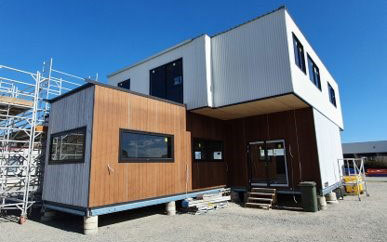Testing the circular economy principles in the prefabricated construction industry
Overview

The circular economy (CE) is typically associated with material savings in the supply chain with follow-on ecological benefits. In this study, we explore empirically when CE has a positive effect on environmental indicators, such as greenhouse gases (GHG) and when CE falls short of generating benefits. The most applied strategy to decrease the impact of constructions seems to be recycling building components. This research aims to assess the life cycle of our prototype building (L3) [see Figure] designed for deconstruction and reuse and compare the results with the standard practices of recycle and landfill the traditional modular building materials.
Key outcomes
In the production process, the circular L3 emits about 30% less GHG compared to the linear version. Owing to the ability to disassemble internal finishes, it does not produce any GHG in its operation stage and most of its materials are recycled or reused, allowing a final global warming potential (GWP) about 10 times less than the linear version (4.5 t CO2−e vs 44.6 t CO2−e). Among other strategies, we reused 16 tons of steel that would have been otherwise recycled. Despite the environmental benefits of recycling steel, we proved that reusing steel leads to greater environmental saving. Designing for adaptability and ability to disassemble internal finishes avoids waste production during the operation stage.
At the end of life, most of the components of the circular L3 are disassembled and reused in next products, whether the best practice would be recycling. Figure 3, however, shows that greater saving in all the environmental categories studied can be achieved through reusing components instead of recycling them.
Research team
- Tim O’Grady
- Roberto Minunno
- Greg Morrison
- Heap-Yih (John) Chong
- Dr Jemma Green
Research partners and collaborators
- Curtin University
- Fleetwood